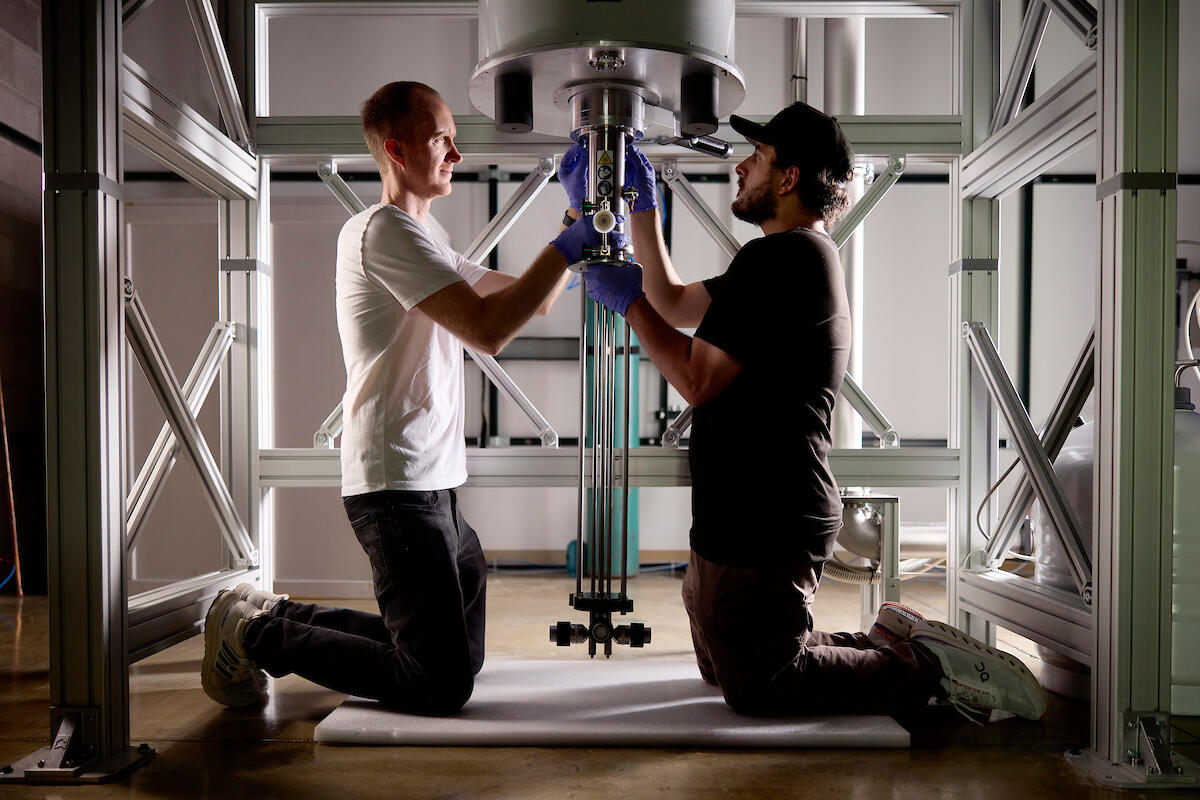After so many consecutive days of temps over 115 degrees this summer, it’s hard to believe that UNLV can now claim home to the coldest spot in the state.
That bragging point came when researchers in the College of Sciences installed their new dilution refrigerator, the only such device in Nevada. It can dip down to and maintain a bone-chilling temperature of 8 millikelvin (approximately -459.6556 degrees below Fahrenheit).
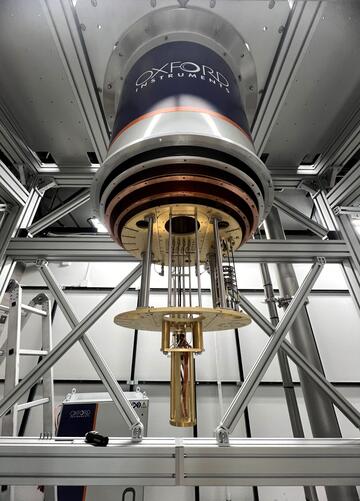
“For some more perspective,” says astronomy and physics assistant professor Joshua Island, “the temperature of outer space is 2.7K. So, the new fridge can cool objects down to a temperature that is 300 times colder than outer space.”
At that low temperature, UNLV physics and astronomy faculty can experiment with materials and devices, such as quantum particles and millimeter-sized superconductors. It's research, says Island, that could lead to advancements in fields like quantum computing.
What the Fridge?
With its covering on, the dilution refrigerator resembles a furnace unit, but inside expect to see an intricate web of tubes, wires, and bolts that look something like the Galactic Empire’s laser cannons in Star Wars.
Like your kitchen fridge, it relies on a refrigerant to keep the inside cold, but in this case it’s helium. (More on how the dilution refrigerator works below.) Helium is the only substance in the universe that can maintain a liquid state near absolute zero.
“There are interesting phenomena in materials that can only be measured at very low temperatures,” Island explains. “For instance, phases of matter that occur due to interactions between electrons generally cannot be observed at room temperature because the electrons and the parent crystal have too much energy.
“The dilution fridge allows us to cool the materials down, lowering the electron temperature and reducing crystal vibrations, in order to reveal new states of matter.”
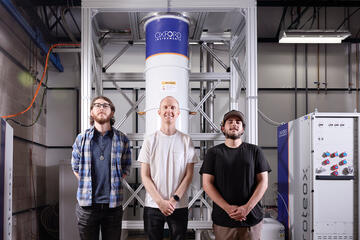
Island, who’s been teaching at UNLV for five years, is one of this year’s recipients of the Regents’ Rising Researcher Award. He oversees a team of undergraduate, graduate, and high school students in the Island Lab, which focuses on low-dimensional materials in electronic devices, like semiconductors.
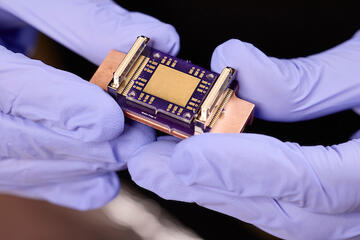
Now that the dilution fridge gives him access to such super low-temperatures, Island says that there are a few different research directions his team can pursue.
“The first,” he says, “is fabricating and measuring new types of qubits that could be used for better quantum computers.”
Taking the Quantum Leap
Quantum computers aren’t a physical object, you can’t use one to check your email; rather, they are a system of artificially created particles (qubits) that work like a brain and, together, can solve difficult computations much faster than a classical computer.
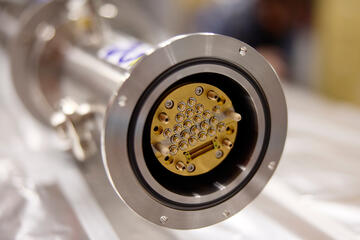
“These qubits are theoretically predicted to be protected from decoherence and noise,” Island says, “which will then extend computation time and memory storage.
“We are also using the fridge to look for correlated (interacting) states in new materials that have not yet been explored.”
Qubits — short for quantum bits — are similar to “bits” used in classical computers. Both bits and qubits contain information that are used to make computers perform certain functions. They also work using a binary code (1s and 0s). In the case of bits, the 1s and 0s can only stand for a single value: just 1 or 0. Sort of like a switch being in either the on or off position.
Qubits can hold multiple values at once through the laws of quantum mechanics (imagine a light being both on and off at the same time!). This is what is called “superposition,” and it’s why quantum computers can perform complex computations. Adding to that, the qubits can become “entangled” with each other, making it possible for them to share information, almost like a network of neurons that are growing and entwining.
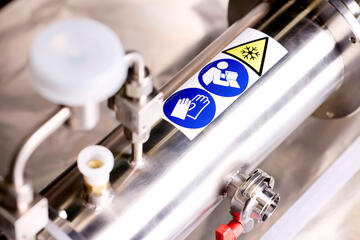
And, while quantum computers use algorithms to solve complex problems, they're still limited in the amount of operations they can do.
“These quantum machines might not be able to perform even the simplest calculations, like 1+1,” says astronomy and physics professor Yan Zhou, “but, due to their inherent quantum properties, they could detect specific signals that are difficult or impossible to observe with classical detectors.”
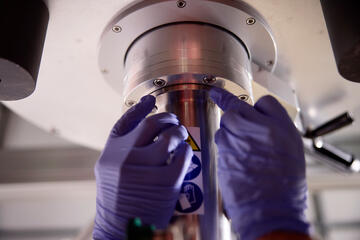
With the dilution fridge now plugged in and powered up, Island will lend out his very cool device to and collaborate with professors like Zhou, Bernard Zygelman, and Clemens Heske, all fellow faculty in UNLV’s physics and astronomy department.
Zhou intends to use the dilution refrigerator to pursue his research interests in artificial optomechanical systems and quantum computation.
“At higher temperatures, such as those above 100 mK, thermal noise becomes a significant issue,” he says. “This noise, particularly in the microwave regime, can interfere with the quantum states of the superconducting qubits. Thermal energy at these higher temperatures can cause qubits to decohere.”
When qubits decohere, they lose their quantum superpositions and entanglements. This results, says Zhou, in errors in quantum computations and ends up limiting the performance and reliability of the quantum computer.
“Quantum computers are challenging to work with because the quantum states of the qubits are very sensitive to noise and decoherence,” Island confirms. “This means that they can lose their information in short amounts of time.”
Which is why Island is up to the task of creating a more resilient qubit through the use of fractional electrons. If he and his team are able to produce a qubit more immune to environmental factors, it would increase the quantum computer’s computation time.
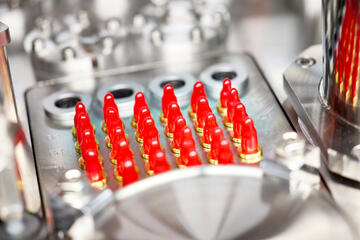
Big Tech Enters the Race
The first “modern” quantum computer was built by researchers at Oxford University in 1998. Since then, big tech companies such as Google, IBM, and Microsoft — have, like Island, been in the race to develop a more stable and reliable quantum computer.
“There is an international race to build a fully functional quantum computer, with both large companies and start-ups participating,” says physics and astronomy professor Bernard Zygelman.
Zygelman, a theoretical physicist, says he was able to use a publicly available quantum computer from IBM for a Quantum Computing and Information course. But now, there’s such a high demand for their use, that they’re no longer accessible for educational purposes.
“Twenty years ago, many scientists thought it would be impossible to build such a machine. Because of incremental advances, today, a majority of scientists believe that a fully functional and commercially viable quantum computer will be built within the next 10 years.”
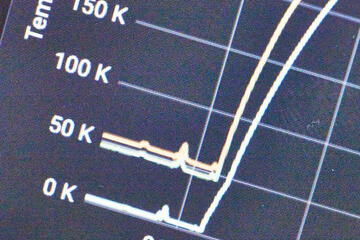
And, while understanding the science behind quantum computer technology can seem daunting, there is one significant application most will be familiar with: cybersecurity.
“The problems we are currently aware of that are relevant for quantum computing already makes quantum computers very valuable,” says Island. “For instance, our encryption systems are based on the inability to factor very large numbers. Quantum computers, in theory, will be able to factor large numbers much faster than regular computers, rendering our encryption protocols useless.”
Island notes that such security breaches wouldn’t happen right away and that researchers will find better ways of encrypting data as quantum computers become more readily available.
The Future is Quantum
It’s likely that within Justin Alvarez’s lifetime, he — along with the other students working in Joshua Island’s lab — will be able to see the potential applications of these highly complex “machines” transition from what could be to what is.
“An example of one of the future uses for quantum computing can be the ability for researchers to simulate the quantum mechanical behavior of complex molecules,” says Alvarez, a graduate student in the physics program. “Today, even the best supercomputers struggle with this problem.”
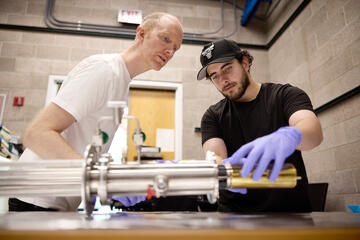
The continued evolution of qubits and quantum computers could also lead to further advancements in the fields of medicine, logistics, manufacturing, and finance.
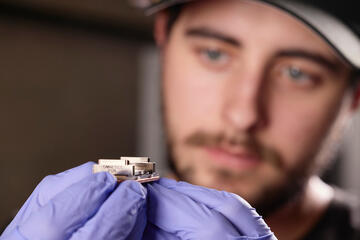
“As the field of quantum computing develops further, I believe not only researchers will benefit,” says Alvarez. “For example, in the future, industries such as those involved in pharmaceutical development could use the benefits of quantum computing to study molecules quickly and speed up drug development stages.”
Inspired by his time in Island Lab, Alvarez says he wants to pursue a Ph.D. in physics after he finishes his master’s. He plans to continue in academia and eventually become a professor.
Says Alvarez, “I started working with Dr. Island during my undergrad and not only have I learned countless hands-on skills such as circuit design, nanofabrication techniques, etc. I've also learned how to take measurements of nanoscale devices, interpret data, and present my research. I would say that, overall, working with Dr. Island has helped develop my skills as a researcher."
Science Behind Fridge Is an Absolute Gas!
Researchers in UNLV’s College of Sciences received a $621,000 grant from the U.S. Department of Defense to purchase and install its new dilution refrigerator this summer.
Unlike a regular fridge, which commonly used freon before more environmentally friendly options became available, a dilution fridge uses two helium isotopes (He-3 and He-4). The mixture of the isotopes is what allows for the temperature to plunge to such extreme lows, says physics and astronomy professor Joshua Island.
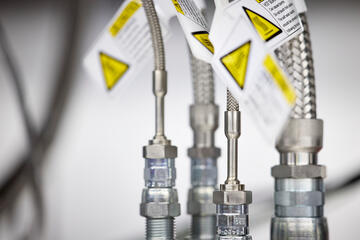
Dropping the dilution fridge to its coldest temps takes about three days once it's been turned on. Each time a new sample is added, it takes 7 to 8 hours before the machine is cool enough again to begin the next experiment.
And, for those who may wonder about the environmental footprint a device like this could leave behind, Island assures the power required is less than you’d think.
“The fridge is surprisingly efficient,” says Island. “The He-3 and He-4 are kept in reservoirs and continually reused so very little, if any, is required to be added to the system. The power usage is moderate unless the magnetic field is running, in which case, large currents are used to ramp the field up and down. Operating costs are limited to some routine maintenance.”
